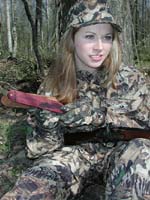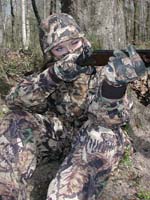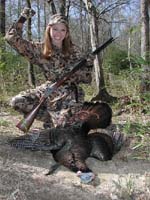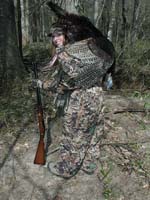
|
Features
|
|
|
|
Books
|
|
|
|
Fun & Games
|
|
|
|
Contact Us
|
|
|
John's Journal... Entry 86, Day 2
Why Turkeys Vanish
 EDITOR'S
NOTE: For more than 43 years, Dr. Dan Speake has researched wildlife.
He has studied turkeys for almost four decades, beginning his love affair
with the wild turkey in 1966. Retired as the leader of the Cooperative
Research Unit at Auburn University in Auburn, Alabama, he now teaches
at Auburn University. A very knowledgeable researcher and turkey hunter,
Speake tells us about some of his findings that have increased everyone's
knowledge of wild turkeys and helped to expand the population of the wild
turkey.
EDITOR'S
NOTE: For more than 43 years, Dr. Dan Speake has researched wildlife.
He has studied turkeys for almost four decades, beginning his love affair
with the wild turkey in 1966. Retired as the leader of the Cooperative
Research Unit at Auburn University in Auburn, Alabama, he now teaches
at Auburn University. A very knowledgeable researcher and turkey hunter,
Speake tells us about some of his findings that have increased everyone's
knowledge of wild turkeys and helped to expand the population of the wild
turkey.
In our early research, I learned that a turkey's home range wasn't as small as that of deer and other animals. Turkeys would migrate some distance to find the habitat requirements they needed at specific times of the year. For instance, on three of the areas that my research group studied, we found that turkeys moved 6 or 7 miles from the places they lived in the fall and winter to find suitable spring nesting and brood-rearing sites.
 Once
we learned about the turkeys' seasonal migration to discover appropriate
habitat, we could explain why a region would have plenty of turkeys in
the fall during deer season and very few, if any, turkeys in the spring
in that same place. When the hens migrated from their fall and winter
ranges to their nesting and brood sites, they took the gobblers with them.
This information also helped us advise landowners and hunting clubs to
create more wildlife openings for nesting and brood-rearing sites if they
wanted to keep and maintain plentiful turkey populations on their properties
year-round.
Once
we learned about the turkeys' seasonal migration to discover appropriate
habitat, we could explain why a region would have plenty of turkeys in
the fall during deer season and very few, if any, turkeys in the spring
in that same place. When the hens migrated from their fall and winter
ranges to their nesting and brood sites, they took the gobblers with them.
This information also helped us advise landowners and hunting clubs to
create more wildlife openings for nesting and brood-rearing sites if they
wanted to keep and maintain plentiful turkey populations on their properties
year-round.
I also learned after studying several hundred turkeys and using radio telemetry to investigate turkey mortality that 25 percent of the hens each year were killed during nesting and brood-rearing times. We also learned that on the average, 70 percent of the poults were killed within the first two weeks after hatching. In Alabama where we conducted this research, free-ranging dogs were the number-one predator of hens sitting on their nests with raccoons the number-two predator. Gray foxes, bobcats and coyotes also were responsible for the demise of some hens. But the number-one predator on the nests -- the animals that disturbed the nest and ate the eggs -- was the raccoon, and the number-two predator on the nests were free-ranging dogs. Possums, crows and gray foxes also were found to be nest predators, but they didn't prove to be as significant a problem as the coons and the dogs. As we studied the young poults, we found that coons were the number-one predator on the young turkeys and dogs the number-two predator. Hawks, owls and snakes took some of the poults.
 We
found that if we eliminated predation from the dogs, the coons and the
possums, then the turkey population would grow rapidly, with about a 300-percent
increase in the production of turkeys than before when predators killed
hens and poults, ate eggs and disturbed nests. We also learned that the
older-age-class gobblers were almost never vulnerable to predators. Very
rarely would an older gobbler put himself in a position in which a predator
could attack and kill him.
We
found that if we eliminated predation from the dogs, the coons and the
possums, then the turkey population would grow rapidly, with about a 300-percent
increase in the production of turkeys than before when predators killed
hens and poults, ate eggs and disturbed nests. We also learned that the
older-age-class gobblers were almost never vulnerable to predators. Very
rarely would an older gobbler put himself in a position in which a predator
could attack and kill him.
 To
learn more about hunting turkeys, go back to Night Hawk's home page, and
click on books. You'll find information there on three turkey-hunting
books written by John E. Phillips that contain interviews with some of
the nation's top turkey hunters. Then call (800) 627-4295 to receive a
brochure or to order a book.
To
learn more about hunting turkeys, go back to Night Hawk's home page, and
click on books. You'll find information there on three turkey-hunting
books written by John E. Phillips that contain interviews with some of
the nation's top turkey hunters. Then call (800) 627-4295 to receive a
brochure or to order a book.
TOMORROW: Where Turkeys Live
Check back each day this week for more about What I've Learned In Almost Four Decades Of Studying Turkeys ...
Day 1 -Speake's Turkey Research
in the Early Years
Day 2 -Why Turkeys Vanish
Day 3 -Where Turkeys Live
Day 4 -What Hunting Pressure Does to Turkeys
Day 5 -How Fast Turkey Populations Grow